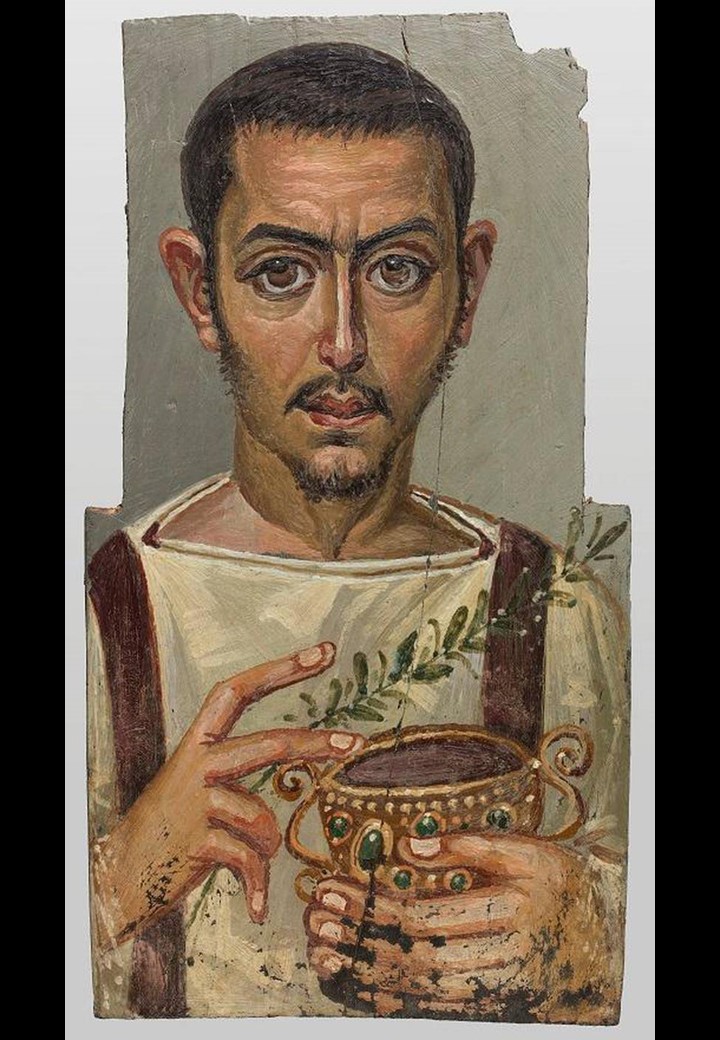
https://www.thenationalnews.com/arts-culture/art/louvre-abu-dhabi-joins-global-research-project-to-analyse-ancient-mummy-portraits-1.1062790
For those fascinated with the past, it’s a recurring dream… to be able to “unlock” the doors of history… and see the faces of people who lived two thousand years ago… look them in the eye, capture their expressions, their personalities, and feel their presence. It is precisely this unusual experience that the Fayoum Portraits offer… Sometimes thanks to their faultless realism, and sometimes thanks to the clarity of their schematization… writes Euphrosyne Doxiadi, and I think of the Fayum Portrait of a Man with a Cup in the Louvre Abu Dhabi Museum https://www.politeianet.gr/books/9789605000158-doxiadi-eufrosuni-adam-portreta-tou-fagioum-135477
The Funerary Portrait of a Man with a Cup in the Louvre Abu Dhabi is, rightly so, a Museum Highlight! Clad in a Roman tunic and holding a myrtle branch and a cup filled with wine, a man in his prime looks out on us from ancient times. He comes from Egypt, probably the city of Antinoöpolis… and hopefully, the Questions and Answers that follow will help us better understand the importance of the Fayum Funerary Portraits.
What is a Fayum Portrait? Fayum Portraits are Mummy Portraits of men, women, and children of all ages, created in Egypt during the Roman period. They were popular from the 1st century AD to the 3rd or, according to other scholars, until the 4th century AD. Even though cremation was the preferred Roman custom for dealing with the dead, the Romans who settled in Egypt, like the Greeks before them, adopted the Egyptian rituals of embalming and mummification. It is believed that the Fayum Portraits were painted while the sitters were alive, to be specifically used after their deaths, and thus replace the Egyptian funerary three-dimensional mask on the mummies’ faces. This development achieved two complementary aims: to preserve the face of the deceased for all eternity and to honour his or her memory in accordance with Greek and Roman practices. https://www.louvreabudhabi.ae/en/explore/highlights-of-the-collection/Funerary-Portrait-of-a-Man-with-Cup
Why are they popularly called Fayum Portraits? The first Fayum Portraits to reach Western Europe and the US, back in the late 1880s, came from Egypt’s Fayum Oasis. Since then, Fayum Portraits have been discovered in various locations in Egypt, like the cemetery of Antinoöpolis, where the Fayum Portrait of a Man with a Cup in the Louvre Abu Dhabi Museum was probably excavated. Today, about 1,000 Fayum paintings exist in collections in Egypt and at many Museums around the world.
What materials were used to create these artworks? Fayum Portraits were created by anonymous but brilliant artists on a thin panel of wood or linen cloth with two different Greek painting techniques: encaustic or tempera. Artists using the Encaustic Painting Technique work with pigments mixed with hot liquid wax. After the paint has been applied to the support, which is usually made of wood, plaster, or canvas, a heating element is passed over the surface until the individual brush or spatula marks fuse into a uniform film. This “burning in” of the colours is an essential element of the true encaustic technique. It was the ancient Greeks who invented the encaustic technique with brilliant final results, attractive effects, elegance, and expressive brushwork. The artists who use the Tempera Painting Technique, on the other hand, operate with fast-drying colored pigments mixed with a water-soluble binder medium, usually glutinous material such as egg yolk. https://www.britannica.com/art/encaustic-painting and https://en.wikipedia.org/wiki/Tempera
What is so special about the Fayum Portraits? I can not write it better… The images seem to allow us to gaze directly into the ancient world. “The Fayum portraits have an almost disturbing lifelike quality and intensity,” says Euphrosyne Doxiadis, an artist who lives in Athens and Paris and is the author of The Mysterious Fayum Portraits. “The illusion, when standing in front of them, is that of coming face to face with someone one has to answer to—someone real.” https://www.smithsonianmag.com/history/the-oldest-modernist-paintings-20169750/
Who is the Man with a Cup on the Louvre Abu Dhabi Museum? According to the Museum experts… Clad in a Roman tunic and holding a myrtle branch and a cup filled with wine, the Man with a Cup, is depicted in his prime as he looks out on us from ancient times. Probably painted during his lifetime, his serious, hollow-cheeked face is rendered with remarkable skill. The anonymous artist of the Portrait was trained to combine Hellenistic naturalistic draftsmanship with Roman realism. While his long, straight, narrow nose, fleshy lips, moustache, and beard are all details that lend individuality, his disproportionately large eyes and fixed and captivating gaze are directly derived from the Egyptian tradition of representation. Interestingly, it combines two civilizations: the Greco-Roman aesthetics with ancient Egyptian culture all in one work of art. https://www.louvreabudhabi.ae/en/explore/highlights-of-the-collection/Funerary-Portrait-of-a-Man-with-Cup and https://www.thenationalnews.com/arts/louvre-abu-dhabi-stories-immortal-figures-showcasing-art-from-different-civilisations-to-open-at-manarat-al-saadiyat-1.76555
For a PowerPoint titled 10 Favorite Fayum Portraits, please… Click HERE!
A Lecture by Euphrosyne Doxiadi, on the funerary portraits of Fayum, in Greek… https://www.blod.gr/lectures/ta-portraita-tou-fagioum/